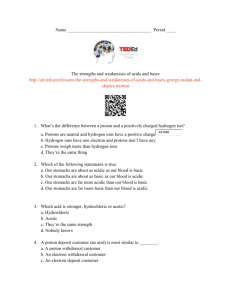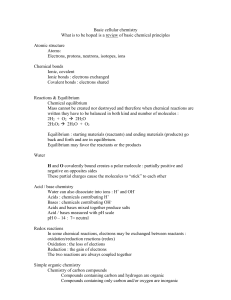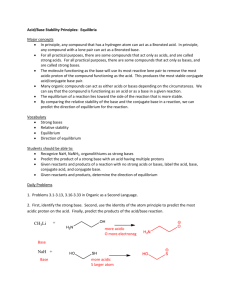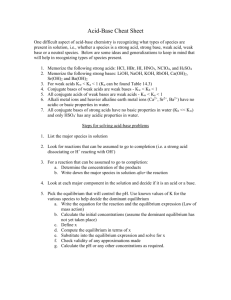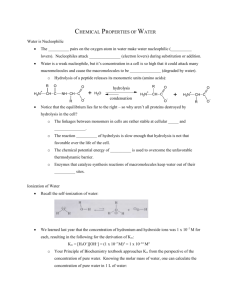Acids and bases
advertisement
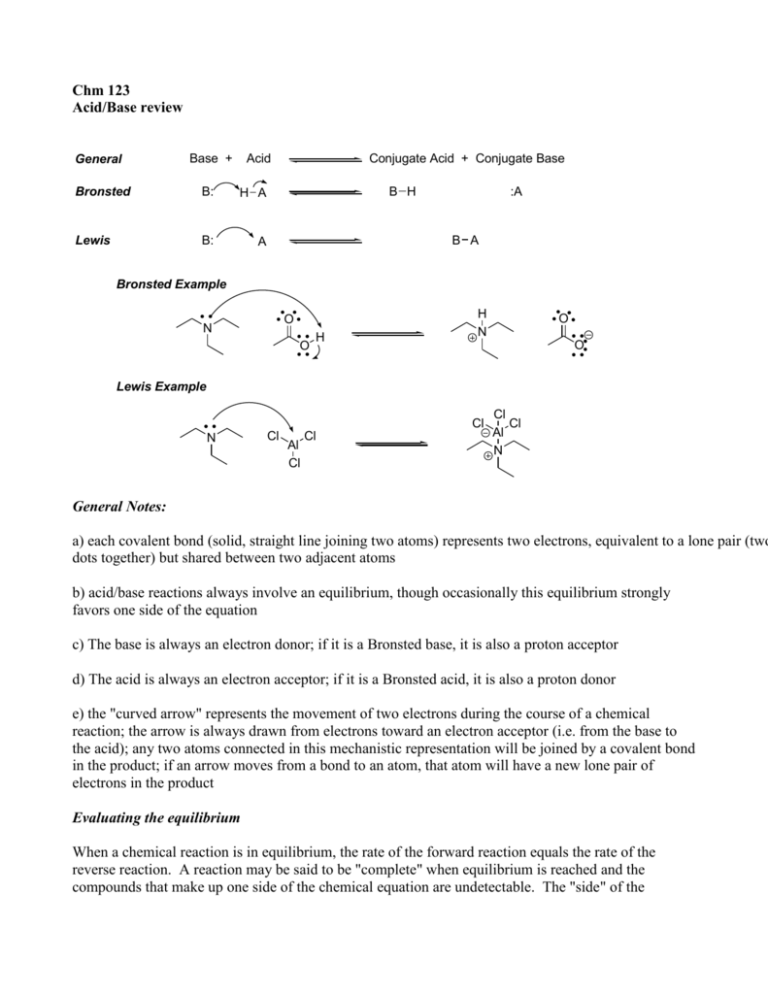
Chm 123 Acid/Base review General Base + Acid Bronsted B: H A Lewis B: A Conjugate Acid + Conjugate Base B H :A B A Bronsted Example O N O H H N O O Lewis Example Cl N Cl Al Cl Cl Cl Cl Al N General Notes: a) each covalent bond (solid, straight line joining two atoms) represents two electrons, equivalent to a lone pair (two dots together) but shared between two adjacent atoms b) acid/base reactions always involve an equilibrium, though occasionally this equilibrium strongly favors one side of the equation c) The base is always an electron donor; if it is a Bronsted base, it is also a proton acceptor d) The acid is always an electron acceptor; if it is a Bronsted acid, it is also a proton donor e) the "curved arrow" represents the movement of two electrons during the course of a chemical reaction; the arrow is always drawn from electrons toward an electron acceptor (i.e. from the base to the acid); any two atoms connected in this mechanistic representation will be joined by a covalent bond in the product; if an arrow moves from a bond to an atom, that atom will have a new lone pair of electrons in the product Evaluating the equilibrium When a chemical reaction is in equilibrium, the rate of the forward reaction equals the rate of the reverse reaction. A reaction may be said to be "complete" when equilibrium is reached and the compounds that make up one side of the chemical equation are undetectable. The "side" of the equation that is favored is the side that has the lowest overall energy. Often, it is possible to simply compare the relative energies of one reagent on each side. This is the case with acid/base reactions. A quick note: a molecule's "energy" refers to its Gibbs free energy (G). A detailed discussion of G is beyond the scope of this course and will be revisited in Chm 280, 341 and 361. G is a combination of enthalpy (H) and entropy (S). Enthalpic concerns are things like how strong the bonds are, how much strain the molecule possesses due to favorable or unfavorable alignments of atoms, bonds and electrons. Entropic concerns are a reflection of the amount of order in a system. Nature would like to see disorder increase (a rise in entropy) while some reactions make a more ordered system. In every reaction, enthalpy and entropy will both undergo some change and this is reflected in the Gibb's Free Energy calculation by the famous equation: G = H –TS A negative change in G implies a "spontaneous" reaction. All of this is the realm of thermodynamics, which is the study of systems at equilibrium. It is possible for a set of reagents to be stable on the disfavored side of a reaction because the movement from that state to the more stable system is slow. That is a kinetic argument: remember that in chemistry, kinetics is the study of how fast chemical change occurs; thermodynamics is the study of which chemical changes are favored. --To judge the position of the equilibrium in an acid/base reaction, one must know the relative strengths of the two acids involved. This is typically done with pKa values. Consider the equilibrium of a dilute acid in water, where water serves as both the solvent and the base: H-A + H2O H3O+ + A- [H3O+][A-] K= [H2O][H-A] The equilibrium constant, K, is shown to the right of the chemical equation. In this case, because the reaction is carried out in water, the concentration of water is (at least is very, very, very close to being) constant. Thus, it can be assumed and a new equilibrium expression, termed "Ka" is born: [H3O+][A-] Ka = [H-A] pKa is –log Ka (it is exactly analogous to pH). One result of this math is that an acid with a pKa of, say, 4.2 will be exactly 50% dissociated in an aqueous solution at pH 4.2. (Do the math: pH = -log[H3O+]). Another is that one can judge acid strength by knowing the pKas of the various acids one wishes to compare. The lower the pKa, the stronger the acid. A list of acids and approximate pKa values that will be in common use in Chm 123 can be found on the next page. The acids are listed in decreasing order of strength. Therefore, note that any acid in the table will undergo spontaneous reaction with the conjugate base of any acid below it. Also note that all of the acids shown are Bronsted acids. name acid pKa conjugate base sulfuric acid O HO S OH O -10* hydrochloric acid H-Cl -6* Cl chloride methanesulfonic acid O H3C S OH O -2* O H3C S O O methanesulfonate O O S OH O O OH F3C H3O+ trifluoroacetate O F3C H2O 0 O benzoic acid 4.2 O O acetate 4.8 OH NH4+ O NH3 9.25 OH phenol H N O H H acetone ammonia O OEt H2O ethanol N 10.8 O ethylacetoacetate OH O H NH3 14 OH 16* O O NH2 H benzene methane 40* CH4 49* triethylamine OEt H 32* phenolate O 12 19* ammonia O 10 triethylammonium ion benzoate O acetic acid water water O OH ammonium ion hydrogen sulfate O 0.5 trifluoroacetic acid hydronium ion name CH3 * pKa values less than zero or greater than 14 are difficult to measure accurately hydroxide ethoxide acetone enolate amide Any compound with protons can, theoretically, serve as a Bronsted acid. Clearly, some are stronger acids than others. Remember that the pKa values shown in the table on the preceeding page are in logarithmic units (the definition of "p"). Hence, sulfuric acid is, approximately, 60 orders of magnitude (1060) stronger a Bronsted acid than is methane. That is, simply put, a big difference. If you could get a mole of sulfuric acid together with a mole of CH3 (methyl) anion, the reaction would spontaneously proceed until there was no more methyl anion (1023 molecules, but favored 60 orders of magnitude – you'd need approximately all the atoms in the universe to be only sulfuric acid and methyl anion until you might have one methyl anion hanging about at equilibrium). You may not have any methyl anion left, but you would have a fire. I digress. Another thing to note is that seemingly small changes in molecular structure make fairly large changes in reactivity. This is, actually, the central theme of organic chemistry: structure dictates function. All the properties of an organic molecule, including reactivity (whether acid/base or other) can be predicted on the basis of structure. One last note before we get to some details: stability requires a comparison. Sulfuric acid in a bottle is perfectly stable. Only once you've exposed it to a base does a reaction ensue. It sounds simple, but predicting the outcome of an acid/base reaction requires both an acid and a base. Protons are never spontaneously lost. Thus, when considering acid strength, you have to consider the base it is reacting with. At equilibrium, the reaction will be made up mostly of the acid/base pair with the weaker acid. The magnitude of this difference will depend on the magnitude of the difference in pKa values of the two acids in the reaction. This is best illustrated with an example. Let's look at the first Bronsted acid/base reaction on the first page: N O O H H N O O What is the acid and base on the left side of the equation? The answer is: triethylamine is the base and acetic acid is the acid (helpful tip: when the name of the compound has the word "acid" in it, that compound is usually going to be the acid.) What is the acid and base on the right side of the equation? The answer is: acetate is the base and triethylammonium ion is the acid. Okay, which of these two is the stronger acid? Acetic acid has a pKa of 4.8. Triethylammonium ion has a pKa of 10.8. Acetic acid is, therefore, the stronger acid. So, at equilibrium which side of the equation is favored? That is, at equilibrium, will there be more acetic acid (and, therefore, triethylamine) or acetate (and, therefore, triethylammonium ion)? The weaker acid is favored. Thus, the right side of this equation is favored and there will be more acetate (by about six orders of magnitude) than acetic acid in the mixture. Note that it doesn't matter in which direction the equation is written. If acetate and triethylammonium had appeared on the left and acetic acid and triethylamine on the right, then the left would have been favored. What matters are the molecules. You may ask yourself why the bases need not be considered in that analysis. But, the bases ARE considered. What are the two acids you considered? Acetic acid and triethylammonium. Those are one each of a pair. Acetic acid/acetate is one pair and triethylammonium/triethylamine is the other. By considering the two acids, one on each side of the equation, you consider one from each acid/conj. base pair. In such a pair, the strength of the conjugate base is inversely related to the strength of the acid. So, if you have a really strong acid, say sulfuric acid, the conjugate base is going to be very weak. Conversely, if you have a really weak acid, say methane, the conjugate base is going to be very strong. Thus, in the table above, while the acids are listed down the page in decreasing order of strength, the conjugate bases are listed down the page in increasing order of strength. Things to consider when predicting acid strength: 1) What atom gains (or loses) charge? Simply put, the more electronegative the atom that gains electrons in the reaction, the more favored the reaction will be. Imagine a general base, B, reacts with three different acids: CH4 + B BH + CH3 NH3 + B BH + NH2 H2O + B BH + OH The reactions become more favorable (whatever B is) as you go down this series. Why? In the top reaction, a covalent bond between carbon and hydrogen is broken, resulting in protonation of the base, B. The electrons that had been in the covalent bond that was broken end up on the carbon, which is now part of a methyl anion. In the middle reaction, the same events occur to break a N-H covalent bond and put a negative charge on nitrogen. Finally, the same events in the bottom reaction break an O-H bond and put a negative charge on the oxygen, now part of hydroxide. The order of electronegativity goes: O > N > C. Thus, the oxygen is more stable bearing a negative charge than nitrogen which is, in turn, more stable bearing negative charge than carbon. This is a general trend throughout chemistry. 2) What is the starting charge on the acidic atom (when the acidic atom is the same element)? That sentence is a bit confusing, but it means only this: when comparing two Bronsted acids in which the atom bearing the acidic proton is of the same element, consider what the charge is on that element. Consider these reactions: H3O+ + B H2O + B OH + B BH + H2O BH + OH 2 BH + O In the top reaction, a base, B, is accepting a proton from hydronium ion. In the middle reaction, the acid is water and in the bottom it is hydroxide. In all three acids, the atom bearing the acidic proton is of the element oxygen. The reactions become LESS favorable down the series. In the top reaction, the oxygen is positively charged; in the middle, the oxygen is neutral; finally, in the bottom reaction, the oxygen is negative. (Note that in the bottom reaction, hydroxide, a strong base, is actually acting as an acid. This can happen, but usually doesn't. But it is a good reason not to simply memorize. Understand WHY hydroxide is usually a base.) Why is the top reaction more favorable than the middle (i.e. the top acid is stronger than the middle)? Remember that an acid is an electron acceptor. What will better accept electrons, a cation or a neutral molecule? If all else is equal, the answer is clearly the cation. The same argument holds in comparing the middle to the bottom reaction. What accepts electrons better, a neutral molecule or an anion. Again, all else being equal, the neutral molecule. 3) How "spread out" is the charge (or lone pair) that results from loss of a proton? The words in quote refer to delocalization – how many atoms are involved in the molecular orbital (MO) that the electrons in the A-H covalent bond move into when the proton is taken by the base. This is a more sophisticated argument than the previous two, but as powerful. Anytime an acid loses a proton, the rest of that molecule will gain a lone pair of electrons (and, very often, a negative charge). Though the reasons behind it are beyond the scope of this class, the more atoms that lone pair of electrons can be distributed over, the more stable it will be. This is the foundation of the argument you will often see in organic chemistry about counting resonance structures. Resonance structures are a simple way to approximate the behavior of delocalized molecular orbitals (we will talk more about this in class). For now, an example. Consider these reactions: O HO S OH O B O O O S OH O O H B OH B O BH BH O O BH These reactions are arranged such that the right side of the equation becomes less favored as you move down the series. Why? In each case, the acidic proton is on an atom of oxygen. Thus, negative charge accrues to the same element in each case. The charge on the oxygen bearing the acidic proton is neutral in each acid. Thus arguments 1 and 2 do not explain the difference in acidity of these three acids and, yet, that difference spans 26 pKa units. As you will expect from reading above, the charge is more delocalized in hydrogen sulfate than in acetate and more so in acetate than in ethoxide. Consider the resonance structures of hydrogen sulfate: O O O S OH O O O S OH O O O S OH O means: O S OH O resonance arrows are NOT equilibrium arrows. Resonance arrows imply that the two structures are related by being resonance structures. Resonance structures are generated by moving electrons about the atomic framework of a molecule in such a way that atomic connectivity is not changed, nor are overall charge or valence rules changed. See general review for more details. This is a very important topic to understand. The charge that appears to be on one oxygen atom is actually shared over four atoms (three oxygen and on sulfur). That is, the lone pair gained by loss of a proton is in a MO spread out over four atoms. Thus, three resonance structures can be drawn for hydrogen sulfate. Hydrogen sulfate is, in fact, best represented as a weighted sum of all the resonance structures (pictured far right). A similar operation can be done for acetate: O O O means: O O O In the case of acetate, the lone pair gained from losing a proton from acetic acid is delocalized over three atoms (two oxygen, one carbon). Thus, the lone pair is more delocalized in hydrogen sulfate, implying that sulfuric acid should be more stable than acetic acid and, indeed, it is by almost 15 orders of magnitude. In the case of ethoxide, the lone pair gained is not delocalized. It is fully localized on a single oxygen atom. Remember, to delocalize electrons, they must have access to a bond network. There is none in ethanol. (To put it another way, to draw a resonance structure, one must move electrons but not atoms and not violate any atoms valence rules – this can't be done in ethanol). Thus, we would predict that ethanol would be less acidic than acetic acid and it is by about 11 orders of magnitude. Exercise: why is phenol more acidic than ethanol, but less acidic than acetic acid? Why is HCl more acidic than water?

